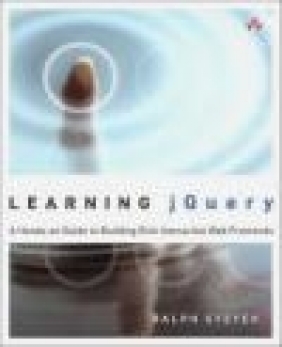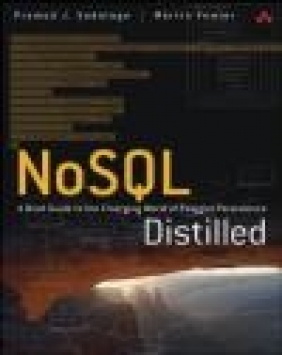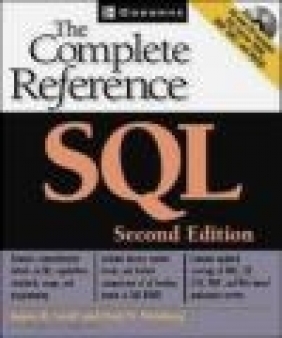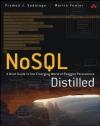NoSQL Distilled
Pramodkumar Sadalage, Martin Fowler
NoSQL Distilled
Pramodkumar Sadalage, Martin Fowler
- Producent: Pearson
- Rok produkcji: 2012
- ISBN: 9780321826626
- Ilość stron: 192
- Oprawa: Miękka
Niedostępna
Opis: NoSQL Distilled - Pramodkumar Sadalage, Martin Fowler
The need to handle increasingly larger data volumes is one factor driving the adoption of a new class of nonrelational "NoSQL" databases. Advocates of NoSQL databases claim they can be used to build systems that are more performant, scale better, and are easier to program. NoSQL Distilled is a concise but thorough introduction to this rapidly emerging technology. Pramod J. Sadalage and Martin Fowler explain how NoSQL databases work and the ways that they may be a superior alternative to a traditional RDBMS. The authors provide a fast-paced guide to the concepts you need to know in order to evaluate whether NoSQL databases are right for your needs and, if so, which technologies you should explore further. The first part of the book concentrates on core concepts, including schemaless data models, aggregates, new distribution models, the CAP theorem, and map-reduce. In the second part, the authors explore architectural and design issues associated with implementing NoSQL. They also present realistic use cases that demonstrate NoSQL databases at work and feature representative examples using Riak, MongoDB, Cassandra, and Neo4j. In addition, by drawing on Pramod Sadalage's pioneering work, NoSQL Distilled shows how to implement evolutionary design with schema migration: an essential technique for applying NoSQL databases. The book concludes by describing how NoSQL is ushering in a new age of Polyglot Persistence, where multiple data-storage worlds coexist, and architects can choose the technology best optimized for each type of data access.Preface xiii Part I: Understand 1 Chapter 1: Why NoSQL? 3 1.1 The Value of Relational Databases 3 1.2 Impedance Mismatch 5 1.3 Application and Integration Databases 6 1.4 Attack of the Clusters 8 1.5 The Emergence of NoSQL 9 1.6 Key Points 12 Chapter 2: Aggregate Data Models 13 2.1 Aggregates 14 2.2 Key-Value and Document Data Models 20 2.3 Column-Family Stores 21 2.4 Summarizing Aggregate-Oriented Databases 23 2.5 Further Reading 24 2.6 Key Points 24 Chapter 3: More Details on Data Models 25 3.1 Relationships 25 3.2 Graph Databases 26 3.3 Schemaless Databases 28 3.4 Materialized Views 30 3.5 Modeling for Data Access 31 3.6 Key Points 36 Chapter 4: Distribution Models 37 4.1 Single Server 37 4.2 Sharding 38 4.3 Master-Slave Replication 40 4.4 Peer-to-Peer Replication 42 4.5 Combining Sharding and Replication 43 4.6 Key Points 44 Chapter 5: Consistency 47 5.1 Update Consistency 47 5.2 Read Consistency 49 5.3 Relaxing Consistency 52 5.4 Relaxing Durability 56 5.5 Quorums 57 5.6 Further Reading 59 5.7 Key Points 59 Chapter 6: Version Stamps 61 6.1 Business and System Transactions 61 6.2 Version Stamps on Multiple Nodes 63 6.3 Key Points 65 Chapter 7: Map-Reduce 67 7.1 Basic Map-Reduce 68 7.2 Partitioning and Combining 69 7.3 Composing Map-Reduce Calculations 72 7.4 Further Reading 77 7.5 Key Points 77 Part II: Implement 79 Chapter 8: Key-Value Databases 81 8.1 What Is a Key-Value Store 81 8.2 Key-Value Store Features 83 8.3 Suitable Use Cases 87 8.4 When Not to Use 87 Chapter 9: Document Databases 89 9.1 What Is a Document Database? 90 9.2 Features 91 9.3 Suitable Use Cases 97 9.4 When Not to Use 98 Chapter 10: Column-Family Stores 99 10.1 What Is a Column-Family Data Store? 99 10.2 Features 100 10.3 Suitable Use Cases 107 10.4 When Not to Use 109 Chapter 11: Graph Databases 111 11.1 What Is a Graph Database? 111 11.2 Features 113 11.3 Suitable Use Cases 120 11.4 When Not to Use 121 Chapter 12: Schema Migrations 123 12.1 Schema Changes 123 12.2 Schema Changes in RDBMS 123 12.3 Schema Changes in a NoSQL Data Store 128 12.4 Further Reading 132 12.5 Key Points 132 Chapter 13: Polyglot Persistence 133 13.1 Disparate Data Storage Needs 133 13.2 Polyglot Data Store Usage 134 13.3 Service Usage over Direct Data Store Usage 136 13.4 Expanding for Better Functionality 136 13.5 Choosing the Right Technology 138 13.6 Enterprise Concerns with Polyglot Persistence 138 13.7 Deployment Complexity 139 13.8 Key Points 140 Chapter 14: Beyond NoSQL 141 14.1 File Systems 141 14.2 Event Sourcing 142 14.3 Memory Image 144 14.4 Version Control 145 14.5 XML Databases 145 14.6 Object Databases 146 14.7 Key Points 146 Chapter 15: Choosing Your Database 147 15.1 Programmer Productivity 147 15.2 Data-Access Performance 149 15.3 Sticking with the Default 150 15.4 Hedging Your Bets 150 15.5 Key Points 151 15.6 Final Thoughts 152 Bibliography 153 Index 157
Producent:
GPSR Pearson Central Europe Sp. z o.o.
ul. Szamocka 8
01-748 Warszawa (PL)
tel: 459 596 060
email: [email protected]
Szczegóły: NoSQL Distilled - Pramodkumar Sadalage, Martin Fowler
Tytuł: NoSQL Distilled
Autor: Pramodkumar Sadalage, Martin Fowler
Producent: Pearson
ISBN: 9780321826626
Rok produkcji: 2012
Ilość stron: 192
Oprawa: Miękka
Waga: 0.31 kg






























